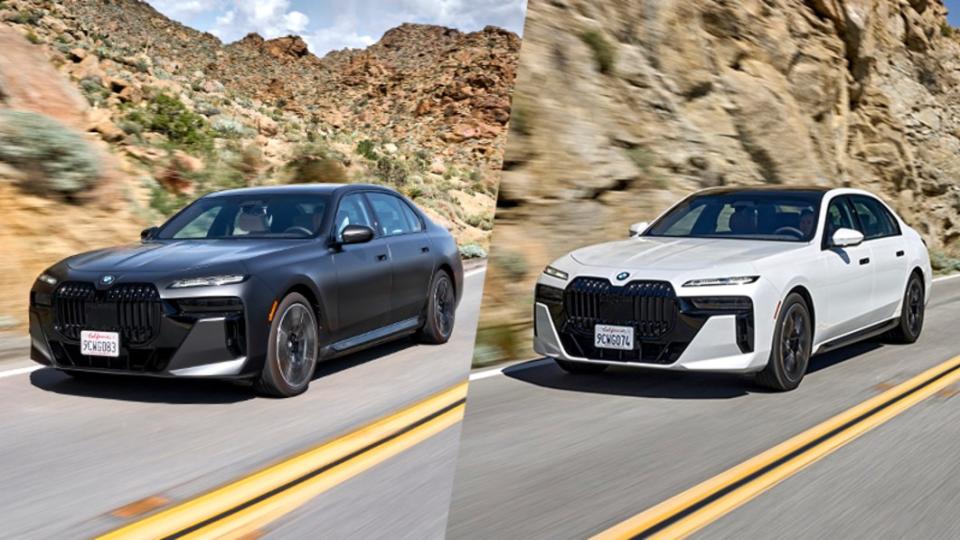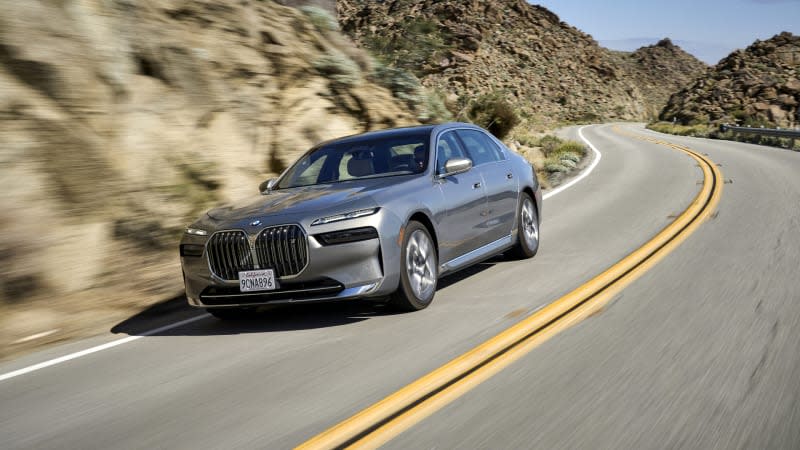2023 BMW i7 vs. 7 Series: Lucky numbers

PALM SPRINGS, Calif. — BMW's flagship 7 Series luxury sedan just received a complete redesign, and in an unusual move, the all-electric i7 was released at the same time. For shoppers who have either embraced or rejected the all-electric future, the decision between the two should be easy. But what if you're on the fence? Here's your primer on the good, the bad and, yes, the ugly when picking which 7 is right for you.
Crunching the numbers is the most objective difference between the two. The 2023 BMW i7 has a starting price of $120,295 (including $995 destination). It has a 107.7-kilowatt-hour lithium-ion battery pack that should return 310 miles. The BMW 760i xDrive starts at $114,595 and has a 4.4-liter turbocharged V8 that should return an estimated 26 miles per gallon in combined city and highway miles.
If you calculate 15,000 miles driven annually with premium unleaded set at $4.00 per gallon and an electricity rate of $0.16 per kWh, it will take you 3.9 years to recoup the i7's $5,700 premium over the 760i. If those metrics remain consistent, you can count on savings of $1,476.89 every year after. That means if you plan on keeping your vehicle for more than four years, it makes more financial sense to go electric with the i7.
That all changes if you opt for the six-cylinder 740i base model that starts at $94,295 and has an estimated 31 mpg in combined driving. In this case, it will take you 23.6 years to recoup the i7 premium and save $1,101.68 in fuel costs annually. For most drivers, this base model 7 Series will more than satisfy and is the sensible choice. Then again, at this level of luxury, sensibility often takes a back seat to prestige.
But what about performance? BMW estimates the i7 will accelerate to 60 mph in 4.5 seconds, which is close enough to the 760i's 4.1-second sprint that we'll call it a draw. It's not like the typical 7 Series driver is going to battle it out at their local quarter-mile drags, right? Both leave the line with immediacy and sound decent doing it. In Sport mode, the i7 emits a pleasing high-tech hum engineered by film composer Hans Zimmer. The 760i has a more authentic V8 burble, but it's also enhanced with some sounds pumped in through the speakers.
It's when the road begins to bend that the difference between the two becomes apparent. The 760i weighs 5,095 pounds while the i7 tips the scales at 5,917 pounds. To the i7's credit, much of that added mass is concentrated in the floor-mounted batteries, giving it a low center of gravity. Earthbound physics won't let those 822 pounds go unnoticed, though.
On the same twisting ribbon of pavement above Palm Springs, the 760i feels light and lively compared to the i7. The i7 acquits itself well in the curves and feels well-planted, but it doesn't encourage you to push as hard as you would in the 760i. Is this really a big deal for a large luxury sedan? Probably not for most people, but this is a BMW after all, and performance is always a corporate talking point.
In everyday driving conditions, both 7s are enjoyable behind the wheel and easy to maneuver thanks to four-wheel-steering. The i7 can be driven in one-pedal mode, though, and that's preferred by most who have experience with EVs. You simply modulate the pressure on the accelerator rather than dance between it and the brake pedal. With very little practice, you can bring the vehicle to a stop right where you intended. Over time, one-pedal driving can alleviate some driver fatigue, but for most, it's simply one of those neat things you can do with an EV.

 Yahoo Autos
Yahoo Autos 

